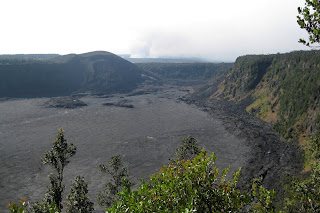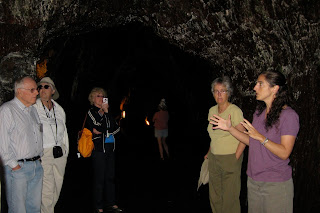
Saturday, January 16 we would spend in Kilauea Volcano National Park. But first, we had a lecture by volcanologist Cheryl Ganseki.
Usually when we think of volcanoes we think of volcanoes at subduction boundaries, where one tectonic plate is moving under another. Eruptions are typically violent. Mount St. Helens is an example. The Hawaiian Islands are different. The Pacific tectonic plate is moving over a hot spot where hot magma from the Earth's interior rises. Part of the process is heat rising, convection, and part is melting due to conduction. The magma flows up and becomes lava. Eruptions are not violent. The flows form a volcano that is shaped like a shield.
Hawaiian shield volcanoes go through several stages.
- Submarine stage. The volcano forms on the seabed. There is a new island forming Southeast of the Big Island. Loihi Seamount is completely underwater.
- Explosive stage. When the volcano reaches the water surface, hot lava meeting water at the surface release large quantities of steam.
- Subaerial stage. Once the volcano has gotten large enough it forms the shield shape and lava flows on top of cooled lava and the flows are relatively gentle. There are caldera and fissure eruptions.
- Postshield stage. Here the lava changes consistency and typically does not flow all the way to the ocean. It increases the slope of the volcano.
- Erosional stage. The volcano becomes dormant, sinks into the seabed due to its enormous weight, and suffers rain and wind erosion and landslides. Thus the island gets smaller.
- Rejuvenation stage. The volcano may become active again with infrequent gentle lava flows.
- Coral atoll stage. Eventually the volcano is reduced to sea level and becomes an atoll surrounded by coral reefs.

We went to Kilauea Volcano in Hawaii Volcanoes National Park. The Park Headquarters had interesting exhibits. One demonstrated how seeds might have arrived on the islands by being stuck to bird feathers and how snails might have been on bird feet. It is not known how a bat might have arrived. Fossil remains indicate it arrived long before people.


Halemaumau caldera where Pele, Hawaiian goddess of fire, lives was our next photo opportunity. The picture at the top of this blog entry is of Pele's home. We went to Sulphur Banks, Steaming Bluff by a fissure wall, and places with gases coming out of the ground.
We went to the Jaggar Museum and Observatory. Outside we had a good view of Pele's home. Then the wind shifted and we were all called inside; too much sulphur dioxide (SO2).

Kilauea Iki lava lake was formed by a 1959 eruption. The lava was much higher (as you can see around the edges) and then drained back into the magma chamber.

Thurston Lava Tube was the next stop. Lava tubes form when lava is flowing; the top hardens; the sides harden; and lava continues to flow inside wearing away the bottom surface; and then the hot lava drains out. In places we could see plant roots coming down from the roof of the lava tube.

We went in search of a lava tree mold. Tree molds form when flowing lava surrounds a tree; cools enough to harden; and then the tree burns away. Here is one from a 1974 eruption. In the foreground is an ohelo plant. Its berries are a favorite food of the Nene.

Next stop, search for the Nene, the Hawaiian goose. The Nene is the state bird of Hawaii, endemic to Hawaii, and has been brought back from almost extinction.
Then we rode among the lava flows along the Chain of Craters Road all the way to the ocean.

After dark we returned to the Jagger Museum for one last look at the crater where Pele lives. [The brightness and contrast of this picture were adjusted with iPhoto.] Then it was back to Kilauea Lodge.
Who would have thought it would be so interesting to spend a day on the side of a volcano‽ [There, I got in an interrobang.]
Kilauea Lodge is located in the village of Volcano, zip code 96785. I thought it would be neat to have the post cards I sent postmarked: Volcano, HI. I walked to the post office. In order to get a feeling for how long it takes the cards to arrive, I typically send myself one too. Not only did the card arrive home after I did, but it had a Honolulu, HI postmark. That's not even the same island!
Tomorrow we head for Kona on the West coast of the Big Island. It will be our base for the remainder of the trip.